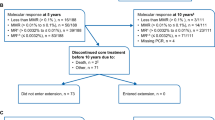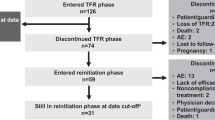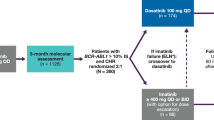Abstract
The STI571 prospective randomised trial (SPIRIT) French trial is a four-arm study comparing imatinib (IM) 400 mg versus IM 600 mg, IM 400 mg + cytarabine (AraC), and IM 400 mg + pegylated interferon alpha2a (PegIFN-α2a) for the front-line treatment of chronic-phase chronic myeloid leukaemia (CML). Long-term analyses included overall and progression-free survival, molecular responses to treatment, and severe adverse events. Starting in 2003, the trial included 787 evaluable patients. The median overall follow-up of the patients was 13.5 years (range 3 months to 16.7 years). Based on intention-to-treat analyses, at 15 years, overall and progression-free survival were similar across arms: 85%, 83%, 80%, and 82% and 84%, 87%, 79%, and 79% for the IM 400 mg (N = 223), IM 600 mg (N = 171), IM 400 mg + AraC (N = 172), and IM 400 mg + PegIFN-α2a (N = 221) arms, respectively. The rate of major molecular response at 12 months and deep molecular response (MR4) over time were significantly higher with the combination IM 400 mg + PegIFN-α2a than with IM 400 mg: p = 0.0001 and p = 0.0035, respectively. Progression to advanced phases and secondary malignancies were the most frequent causes of death. Toxicity was the main reason for stopping AraC or PegIFN-α2a treatment.
This is a preview of subscription content, access via your institution
Access options
Subscribe to this journal
Receive 12 print issues and online access
$259.00 per year
only $21.58 per issue
Buy this article
- Purchase on Springer Link
- Instant access to full article PDF
Prices may be subject to local taxes which are calculated during checkout



Similar content being viewed by others
References
O’Brien S, Guilhot F, Larson RA, Gathmann I, Baccarani M, Cervantes F, et al. Imatinib compared with interferon and low-dose cytarabine for newly diagnosed chronic-phase chronic myeloid leukemia. N Engl J Med. 2003;348:994–1004.
Druker BJ, Guilhot F, O’Brien SG, Gathmann I, Kantarjian H, Gattermann N, et al. Five-year follow-up of patients receiving imatinib for chronic myeloid leukemia. N Engl J Med. 2006;355:2408–17.
Guilhot F, Druker B, Larson RA, Gathmann I, So C, Waltzman R, O’brien SG. High rates of durable response are achieved with Imatinib after treatment with interferon alpha plus cytarabine: results from the international randomized study of interferon and STI571 (IRIS) trial. Haematologica. 2009;94:1669–75.
Hochhaus A, Larson RA, Guilhot F, Radich JP, Branford S, Hughes TP, et al. Long-term outcomes of imatinib treatment for chronic myeloid leukemia. N Engl J Med. 2017;376:917–27.
Graham SM, Jørgensen HG, Allan E, Pearson C, Alcorn MJ, Richmond L, et al. Primitive, quiescent, Philadelphia-positive stem cells from patients with chronic myeloid leukemia are insensitive to STI571 in vitro. Blood. 2002;99:319–25.
Cortes J, Giles F, O’Brien S, Thomas D, Garcia-Manero G, Rios MB, et al. Result of high-dose imatinib mesylate in patients with Philadelphia chromosome—positive chronic myeloid leukemia after failure of interferon-α. Blood. 2003;102:83–6.
Kantarjian H, Talpaz M, O’Brien S, Garcia-Manero G. High-dose imatinib mesylate therapy in newly diagnosed Philadelphia chromosome–positive chronic phase chronic myeloid leukemia. Blood. 2004;103:2872–8.
Guilhot F, Chastang C, Michallet M, Guerci A, Harousseau JL, Maloisel F, et al. Interferon alpha-2b combined with Cytarabine versus Interferon alone in chronic myelogenous leukemia. N Engl J Med 1997;337:223–9.
Guilhot F, Roy L, Guilhot J, Millot F. Interferon therapy in chronic myelogenous leukemia. Hematol Oncol Clin North Am. 2004;18:585–603.
Gardembas M, Rousselot P, Tulliez M, Vigier M, Buzyn A, Rigal-Huguet F, et al. Results of a prospective phase 2 study combining imatinib mesylate and cytarabine for the treatment of Philadelphia-positive patients with chronic myelogenous leukemia in chronic phase. Blood. 2003;102:4298–305.
Baccarani M, Martinelli G, Rosti G, Trabacchi E, Testoni N, Bassi S, et al. Imatinib an pegylated human recombinant interferon-a2b in early chronic-phase chronic myeloid leukemia. Blood. 2004;104:4245–51.
Preudhomme C, Guilhot J, Nicolini F, Guerci-Bresler A, Huguet F, Maloisel F, et al. Imatinib plus pegylated interferon-alpha2a in chronic myeloid leukemia. N Engl J Med. 2010;363:2511–21.
Sokal JE, Cox EB, Baccarani M, Tura S, Gomez GA, Robertson JE, et al. Prognostic discrimination in “good-risk” chronic granulocytic leukemia. Blood 1984;63:789–99.
Johnson-Ansah H, Guilhot J, Rousselot P, Rea D, Legros L, Rigal-Huguet F, et al. Tolerability and efficacy of pegylated interferon-α-2a in combination with imatinib for patients with chronic-phase chronic myeloid leukemia. Cancer. 2013;119:4284–9.
Guilhot J, Baccarani M, Clark RE, Cervantes F, Guilhot F, Hochhaus A, et al. Definitions, methodological and statistical issues for phase 3 clinical trials in chronic myeloid leukemia: a proposal by the European LeukemiaNet. Blood. 2012;119:5963–71.
Ederer F, Heise H. Instructions to Ibm 650 programmers in processing survival computations, Technical, End Results Evaluation Section, National Cancer Institute. 1959.
Gray RJ. A class of k-sample tests for comparing the cumulative incidence of a competing risk. Ann Stat. 1988;16:1141–54.
Marin D, Ibrahim AR, Lucas C, Gerrard G, Wang L, Szydlo RM, et al. Assessment of BCR-ABL1 transcript levels at 3 months is the only requirement for predicting outcome for patients with chronic myeloid leukemia treated with tyrosine kinase inhibitors. J Clin Oncol. 2012;30:232–8.
Hanfstein B, Müller MC, Hehlmann R, Erben P, Lauseker M, Fabarius A, et al. Early molecular and cytogenetic response is predictive for long-term progression-free and overall survival in chronic myeloid leukemia (CML). Leukemia. 2012;26:2096–102.
Hughes TP, Saglio G, Kantarjian HM, Guilhot F, Niederwieser D, Rosti G, et al. Early molecular response predicts outcomes in patients with chronic myeloid leukemia in chronic phase treated with frontline nilotinib or imatinib. Blood. 2014;123:1353–60.
Branford S, Yeung DT, Parker WT, Roberts ND, Purins L, Braley JA, et al. Prognosis for patients with CML and >10% BCR-ABL1 after 3 months of imatinib depends on the rate of BCR-ABL1 decline. Blood. 2014;124:511–8.
Rousselot P, Huguet F, Rea D, Legros L, Cayuela JM, Maarek O, et al. Imatinib mesylate discontinuation in patients with chronic myelogenous leukemia in complete molecular remission for more than 2 years. Blood. 2007;109:58–60.
Mahon FX, Rea D, Guilhot J, Guilhot F, Legros L, Nicolini F, et al. Discontinuation of imatinib in patients with chronic myeloid leukaemia who have maintained complete molecular remission for at least 2 years: the prospective, multicentre stop imatinib (STIM) trial. Lancet Oncol. 2010;11:1029–35.
Saussele S, Richter J, Guilhot J, Gruber FX, Hjorth-Hansen H, Almeida A, et al. Discontinuation of treatment in chronic myeloid leukaemia—prospective analysis of molecular recurrence-free survival in the euro-ski trial. Lancet Oncol. 2018;19:747–57.
Rousselot P, Charbonnier A, Cony-Makhoul P, Agape P, Nicolini FE, Varet B, et al. Loss of major molecular response as a trigger for restarting tyrosine kinase inhibitor therapy in patients with chronic-phase chronic myelogenous leukemia who have stopped imatinib after durable undetectable disease. J Clin Oncol. 2014;32:424–30.
Hehlmann R, Lauseker M, Saussele S, Pfirrmann M, Krause S, Kolb HJ, et al. Assessment of imatinib as first-line treatment of chronic myeloid leukemia: 10-year survival results of the randomized CML study IV and impact of non-CML determinants. Leukemia. 2017;31:2398–406.
Hochhaus A, Saglio G, Hughes TP, Larson RA, Kim DW, Issaragrisil S, et al. Long-term benefits and risks of frontline nilotinib vs imatinib for chronic myeloid leukemia in chronic phase: 5-year update of the randomized ENESTnd trial. Leukemia. 2016;30:1044–54.
Cortes JE, Saglio G, Kantarjian HM, Baccarani M, Mayer J, Boqué C, et al. Final 5-year study results of DASISION: the dasatinib versus imatinib study in treatment—Naïve chronic myeloid leukemia patients trial. J Clin Oncol. 2016;34:2333–40.
Hochhaus A, Baccarani M, Silver RT, Schiffer C, Apperley JF, Cervantes F, et al. European LeukemiaNet 2020 recommendations for treating chronic myeloid leukemia. Leukemia. 2020;34:966–84.
Mahon FX, Delbrel X, Cony-makhoul P, Faberes C, Boiron JM, Barthe C, et al. Follow-up of complete cytogenetic remission in patients with chronic myeloid leukemia after cessation of interferon alfa. J Clin Oncol. 2001;20:214–20.
Nicolini FE, Etienne G, Dubruille V, Roy L, Huguet F, Legros L, et al. Nilotinib and pegylated interferon alfa 2a for newly diagnosed chronic phase chronic myeloid leukaemia patients. Results of a multicentric phase II study. Lancet Haematol. 2015;2:e37–e46.
Hjorth-Hansen H, Stentoft J, Richter J, Koskenvesa P, Höglund M, Dreimane A, et al. Safety and efficacy of the combination of pegylated interferon-α2b and dasatinib in newly diagnosed chronic-phase chronic myeloid leukemia patients. Leukemia. 2016;30:1853–60.
Hochhaus A, Burchert A, Saussele S, Baerlocher GM, Brümmendorf TH, La Rosée P, et al. Nilotinib vs nilotinib plus pegylated interferon α (Peg-IFN) induction and nilotinib or Peg-IFN maintenance therapy for newly diagnosed BCR-ABL1 positive chronic myeloid leukemia patients in chronic phase (TIGER study): the addition of Peg-IFN is associated with higher rates of deep molecular response. Blood. 2019; 134(suppl 1): Abstract 495.
Yeung DT, Shanmuganathan N, Grigg A, Cunningham I, Shortt J, Rowling P, et al. Combination of nilotinib and pegylated interferon Alfa-2B results in high rates of MR4.5 at 24 months—primary analysis of the ALLG CML 11 Pinnacle Study. Blood. 2019; 134(suppl 1): Abstract 2926
Nicolini FE, Etienne G, Huguet F, Guerci-Bresler A, Charbonnier A, Escoffre-Barbe M, et al. The combination of nilotinib + pegylated IFN alpha 2a provides somewhat higher cumulative incidence rates of MR4.5 at M36 versus nilotinib alone in newly diagnosed CP CML patients. Updated results of the petals phase III national study. Blood. 2019;134(suppl 1): Abstract 494.
Acknowledgements
The promoter of the SPIRIT trial is the University Hospital of Poitiers. The trial is supported by grants (national PHRC 2003, PHRC 2006, and PHRC 2011) from the French Minister of Health, Novartis, and Roche Pharma. In addition to the authors, the following investigators participated in the SPIRIT trial: Hôpital Necker Enfants Malades, Paris: B. Varet, A. Buzyn; Hôpital Archet 1, Nice: JP. Cassuto; Hôpital Cochin, Paris: D. Bouscary; Centre Hospitalier De La Côte Basque, Bayonne: A. Banos; Hôpital D’instruction Des Armées, Clamart: B. Souleau; Centre Hospitalier Intercommunal-Hôpital Font-Pré, Toulon-La Seyne-Sur-Mer: C. Sohn; Hôpital d’instruction des Armées de Sainte-Anne, Toulon Naval: L Boudin; Centre Antoine Lacassagne, Nice: A. Thyss; Hôpital Lapeyronie de Montpellier: G Cartron; Hôpital de Lens: B. Dupriez; Institut De Cancérologie De La Loire: D. Guyotat, C. Mounier, J. Jaubert; Polyclinique Du Parc, Caen: X. Levaltier; Service d’Onco-Hématologie, AP-HP Hopitaux Universitaires Paris Sud, Hôpital Paul Brousse, Villejuif, France: A. Turhan. We thank Florence Tartarin for technical assistance (collection of the data, data management and centralisation of allocated treatment, Inserm Centre Investigation Clinique 1402), the clinical-trial monitors (Inserm Centre Investigation Clinique 1402) for their contribution and members of the nursing and research staff at the trial centres.
France Intergroupe des Leucémies Myéloïdes Chroniques, Fi-LMC
Francois Guilhot1, Françoise Rigal-Huguet2, Joëlle Guilhot1, Agnès-Paule Guerci-Bresler3, Delphine Rea5, Valérie Coiteux6, Martine Gardembas7, Anne Vekhoff9, Marc Berger11, Laurence Legros14, Philippe Rousselot15, Pascal Lenain17, Martine Escoffre Barbe18, Viviane Dubruille21, Pascale Cony-Makhoul24, Hyacinthe Johnson-Ansah25, Melanie Mercier26, Charbonnier Aude28, Lydia Roy35, Nathalie Cambier42, Jean-Michel Cayuela46, Jean-Claude Chomel47, Marc Delord50, Claude Preudhomme51, Gabriel Etienne52,François-Xavier Mahon52, Franck-Emmanuel Nicolini53
Author information
Authors and Affiliations
Consortia
Corresponding author
Ethics declarations
Conflict of interest
FG received research support from Novartis and Roche, honoraria from Novartis, BMS and Celgene; DR received honoraria from Incyte, Novartis and Pfizer; EJ received an honorarium from Novartis; LL received honoraria from Incyte, Novartis, Janssen and Pfizer; PR received research support from Pfizer and Incyte; AD received honoraria from Janssen, Abvie, Gilead, Roche, and Amgen; PCM received research support from Novartis, Pfizer, and Incyte and honoraria from Novartis and Incyte; GE received an honorarium from Novartis; FXM received honoraria from Novartis and BMS; and FEN received honoraria from Sun Pharma and Novartis and research support from Incyte.
Additional information
Publisher’s note Springer Nature remains neutral with regard to jurisdictional claims in published maps and institutional affiliations.
Members of the France Intergroupe des Leucémies Myéloïdes Chroniques, Fi-LMC are listed below Acknowledgements.
Supplementary information
Rights and permissions
About this article
Cite this article
Guilhot, F., Rigal-Huguet, F., Guilhot, J. et al. Long-term outcome of imatinib 400 mg compared to imatinib 600 mg or imatinib 400 mg daily in combination with cytarabine or pegylated interferon alpha 2a for chronic myeloid leukaemia: results from the French SPIRIT phase III randomised trial. Leukemia 35, 2332–2345 (2021). https://doi.org/10.1038/s41375-020-01117-w
Received:
Revised:
Accepted:
Published:
Issue Date:
DOI: https://doi.org/10.1038/s41375-020-01117-w
This article is cited by
-
Hepatotoxicity as dose-limiting toxicity of the combination of bosutinib and atezolizumab in patients with chronic myeloid leukemia. Results of the ZEROLMC study
Annals of Hematology (2024)
-
Developing therapeutic approaches for chronic myeloid leukemia: a review
Molecular and Cellular Biochemistry (2023)
-
Switching from imatinib to nilotinib plus pegylated interferon-α2b in chronic phase CML failing to achieve deep molecular response: clinical and immunological effects
Annals of Hematology (2023)
-
Questions concerning tyrosine kinase-inhibitor therapy and transplants in chronic phase chronic myeloid leukaemia
Leukemia (2022)



